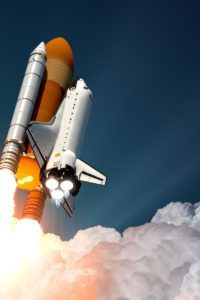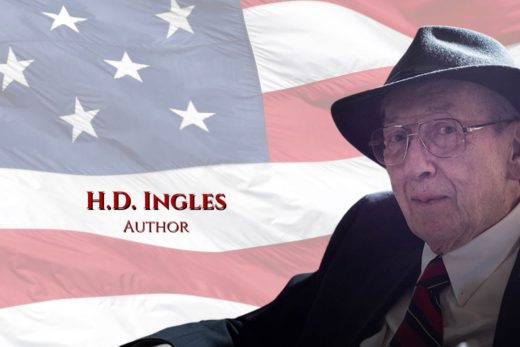Dr. Robert H. Goddard: “It is difficult to say what is impossible, for the dream of yesterday is the hope of today and the reality of tomorrow.” Dr. Goddard is acknowledged to be the father of modern rocketry.
If you were to ask somebody today who invented modern rocket science, he would probably say, “Some German.”
Well, you could look him square in the eye and say, “Wrong.” You see, it’s like this. It’s all because of Robert Hutchings Goddard.
Early Life and Education
Robert Goddard was the only surviving child of Fannie Louise Hoyt and Nahum Danford Goddard.
While still rather young, Robert became interested in science and his parents encouraged Robert by giving him a microscope, a telescope, and a subscription to the Scientific American journal.
At the age of 16, Robert read The War of The Worlds and became fascinated with space flight.
Robert was not a healthy child and fell behind at school. Often too ill to attend classes, he became an avid reader and he made good use of his local library.
His health slowly improved and he attended South High Community School in 1901, graduating in 1904.
College Years at Worcester Polytechnic Institute
Goddard’s fascination with space flight and the means of attaining it continued into his college years at the Worcester Polytechnic Institute, where he earned a B.S. degree in physics in 1908. In an assigned theme, “Travelling in 1950,” Goddard was also intrigued with the notion of “the fastest possible travel for living bodies on the earth’s surface” and projected a plan for travel inside a steel vacuum tube in which cars were suspended and driven by the attraction and repulsion of electromagnets. Patents on a vacuum-tube system of transport were later granted the inventor.
Public Notice
Goddard first obtained public notice in 1907, when he fired a powder rocket in the basement of the Worcester Polytechnic Institute physics building. School officials immediately took an interest in this student’s work. The school’s administration, to their credit, did not expel him. And Goddard began his lifetime work.
After a year as an instructor in physics at the Worcester Polytechnic Institute, Goddard enrolled at Clark University in Worcester and earned a master’s degree in physics in 1910. He received his doctorate from Clark in 1911 and remained there for a year as an honorary fellow in physics, teaching and carrying out rocket experiments.
A Liquid Fuel Rocket
In his small laboratory at Clark University, Goddard was the first to prove that thrust and consequent propulsion can take place in a vacuum and didn’t need to push against air to fly. He was the first to explore mathematic the ratios of energy and thrust per weight of various fuels.
Goddard was the first to develop a rocket engine using liquid oxygen and gasoline. And he seems to have been the first to realize that to propel a rocket beyond the atmosphere, liquid oxygen was required.
In 1914, Goddard received two U.S. patents. One was for a rocket using liquid fuel. The other was for a two- or three-stage rocket using solid fuel.
At the Aberdeen Proving Ground in Maryland, Goddard developed and then demonstrated the basic idea of the “bazooka” two days before the World War I Armistice in 1918.
Extreme Altitudes
In 1919, the Smithsonian published Goddard’s research, a treatise titled “A Method of Reaching Extreme Altitudes.” In this treatise, Goddard detailed his search for methods of raising weather-recording instruments higher than sounding balloons. Goddard also developed the mathematical theories of rocket propulsion.
Goddard’s 1919 treatise also contained an idea deemed impossible at that time. He discussed the possibility of escaping the Earth’s gravity completely. According to his calculations, a rocket could one day travel to the moon and explode a load of flash powder to mark its arrival.
The press immediately derided the idea of travel in outer space. Many people believed there could be no thrust in the vacuum of space. Goddard received a great deal of attention, mostly negative.
In 1920, the New York Times published a scathing editorial scoffing at Goddard’s idea.
To quote part of the editorial, “… That Professor Goddard with his “chair” in Clark College and the countenancing of the Smithsonian Institution, does not know the relation of action and reaction, and of the need to have something better than a vacuum against which to react — to say that would be absurd. Of course he only seems to lack the knowledge ladled out daily in high schools. …”
Goddard pushed back against the wave of criticism in a Scientific American article later that year, but Newton’s Third Law doesn’t apply to public relations, and his response was mostly drowned out by the attacks. Robert Goddard retreated from the public eye.
Vindicated
Goddard was vindicated by the 1944 launch of a German V-2 guided ballistic missile. But it took until July 17, 1969, the day after the launch of a crewed mission to the Moon, for the New York Times to take back its harsh words. The 1969 correction is almost comically dry and conspicuously doesn’t mention the Apollo mission. The New York Times correction has been referred to as “The correction heard ‘round the world.”
The New York Times did not stop Goddard from his work.
On March 16, 1926, Goddard launched his first liquid fueled rocket; it reached a height of 41 feet and averaged a speed of about 60 miles per hour.
Germany
In 1927, after Goddard’s 1926 launch, the German Rocket Society was established by Wernher von Braun, who was a German physicist and a friend of Goddard.
In 1931, the German Army started research on development of a long-range missile using liquid propellants. Goddard innocently aided the program by answering telephone queries from German engineers. German aggression in the 1930s alerted Goddard to his mistake in aiding Germany.
In technical detail, Goddard’s work largely anticipated the later requirements of the German V-2 missiles. Goddard detailed gyroscopic control, steering by means of vanes in the jet stream of the rocket motor, gimbal-steering (see note, below), power-driven fuel pumps and other devices. In other words, the German V-2 was based on Robert Goddard’s technical detail.
Note: A gimbal is a pivoted support that allows the rotation of an object about a single axis. For example, on a ship, the gyroscopes and shipboard compasses use gimbals to keep them upright with respect to the horizon despite the ship’s pitching and rolling.
It is of interest to note that the liquid fuel, liquid oxygen and gasoline, used by Goddard in 1926 was the identical fuel used to propel the German V-2 rockets during World War II.
Roswell, New Mexico
In the course of his experiments at Roswell, Goddard became the first to shoot a liquid-fuel rocket faster than the speed of sound (1935). He obtained the first patents of a steering apparatus for the rocket machine and of the use of “step rockets” to gain great altitudes. He also developed the first pumps suitable for rocket fuels, self-cooling rocket motors, and other components of an engine designed to carry man to outer space.
Goddard’s experiments and calculations took place at a time when any news of his work drew from the press and the public high amusement that “Moony” Goddard could take seriously the possibility of travel beyond Earth.
At the time, his small rockets, early prototypes of the modern Moon thrusters, achieved altitudes of up to one mile above the prairie.
Goddard’s work “Liquid Propellant Rocket Development” was published in 1936.
World War II
During World War II, Goddard offered his work to the military, but lack of interest in rocket development led to closing the Roswell establishment.
It was also during World War II that the Army developed the bazooka, an anti-tank weapon, similar to the one Goddard had designed at the end of World War I.
Goddard had a small Navy contract for work at Annapolis, Maryland, for development of a jet-thrust booster for seaplane takeoff. That was his only direct participation in the war effort.
Charles Lindbergh and the industrialist and philanthropist Harry F. Guggenheim remained staunch advocates of Goddard and the feasibility of space exploration.
In A Nutshell
Robert Goddard was the first scientist who realized the potential of missiles and space flight. And he contributed directly in bringing them to practical realization. Goddard had a rare talent in both creative science and practical engineering.
Dr. Robert H. Goddard died in 1945, at the threshold of the age of jets and rockets.
Robert Goddard’s contributions to missilery and space flight is an extensive list. Following are some highlights:
– Explored the practicality of using rocket propulsion to reach high altitudes, even the moon (1912).
– Received U.S. patent for of multi-stage rocket (1914).
– Proved that a rocket will work in a vacuum, that it needs no air to push against.
– Developed and fired a liquid fuel rocket (March 16, 1926, Auburn, Mass.).
– Shot a scientific payload in a rocket flight (1929, Auburn, Mass.).
– Used vanes in the rocket motor blast for guidance (1932, New Mexico).
– Developed gyro control apparatus for rocket flight (1932, New Mexico).
– Developed pumps suitable for rocket fuels.
– Launched a rocket with a motor pivoted on gimbals under the influence of a gyro mechanism (1937).
Final Tributes
After his death, the United States government acknowledged Goddard’s work, making a $1,000,000 settlement for the use of his patents.
Clark University named The Goddard Memorial Library in his honor.
NASA established Goddard Space Flight Center in Greenbelt, Maryland, on May 1, 1959.
I also recorded a podcast about Dr. Goddard. Click here to watch it now.





